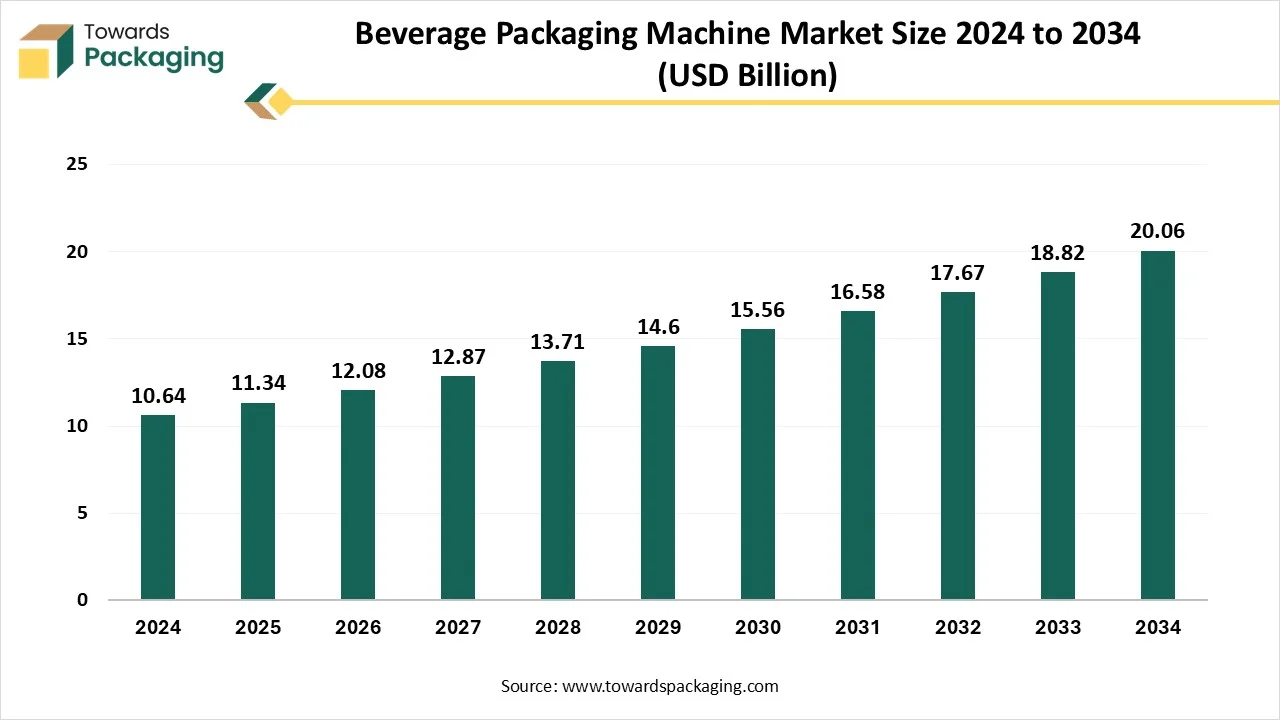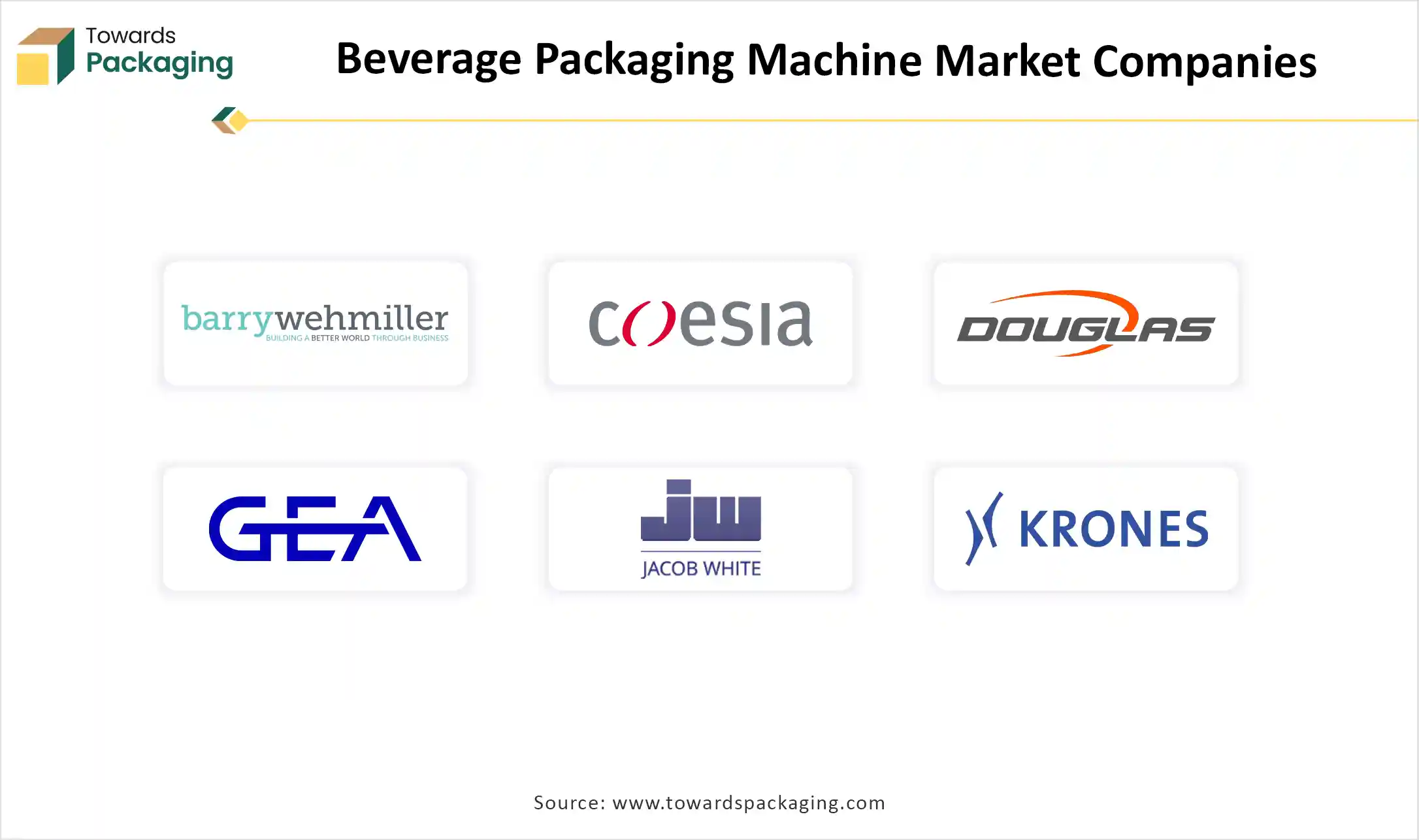The beverage packaging machine market is expanding steadily, growing from USD 11.34 billion in 2025 to USD 20.06 billion by 2034, driven by a 6.53% CAGR. The market covers a wide range of segments including machine type, automation level, beverage type, packaging materials and formats, and distribution channels. Regionally, North America leads in 2024, while Europe is forecast to grow fastest, with Asia-Pacific showing strong momentum due to rising RTD beverage consumption. The study includes full competitive analysis of major companies such as Krones, KHS, Sidel, GEA, Coesia, Barry-Wehmiller, along with value chain mapping, trade flow insights, and manufacturer–supplier relationships across NA, EU, APAC, LA & MEA.

| Metric | Details |
| Market Size in 2024 | USD 10.64 Billion |
| Projected Market Size in 2034 | USD 20.06 Billion |
| CAGR (2025 - 2034) | 6.53% |
| Leading Region | North America |
| Market Segmentation | By Machine Type, By Automation Level, By Beverage Type, By Packaging Format, By Packaging Material, By Distribution Channel, By Region |
| Top Key Players | Barry-Wehmiller Companies, Coesia, Douglas Machine, GEA Group, Jacob White Packaging Ltd. |
A beverage packaging machine is equipment that is designed to automate the process of packaging various types of beverages. These machines offer various functionalities, from capping and filling to labeling and sealing, within a production line. There are some crucial components of beverage packaging machines, including bottle feeder, filling system, capping and sealing mechanism, labeling unit, date and batch coding, packaging line conveyors, and others. Beverage packaging machines find various applications across various industries, such as soft drinks and carbonated beverages, juices and flavored waters, bottled water, energy drinks, and functional beverages. Beverage packaging machines improve production efficiency, reduce human error, and ensure a hygienic packaging process.
Artificial intelligence (AI) integration prevents downtime by predicting maintenance needs and assists in saving costs by avoiding breakdowns. AI can improve the defect detection of beverage packaging machines, enhancing quality and efficiency while minimizing costs. The integration of AI & ML, real-time monitoring systems, and smart labels is reshaping the way beverages are produced, packaged, and delivered. AI algorithms can analyze large amounts of data from production lines. This analysis assists in identifying patterns, predicting equipment failures, and optimizing workflows. Therefore, the integration of the Internet of Things and AI is rapidly revolutionizing the packaging automation in beverage packaging machines as these technologies streamline operations and enhance efficiency.
Growing demand for ready-to-drink beverages
The rising consumer demand for ready-to-drink beverages is expected to drive the growth of the beverage packaging machine market during the forecast period. Beverage packaging machines play a crucial role in the beverage industry, optimizing production processes and products. To automate the numerous tasks, beverage packaging machines can significantly enhance production efficiency, eliminate human intervention, and ensure a hygienic and consistent packaging process for ready-to-drink beverages. These machines cater to ready-to-drink beverages containing various ingredients, maintaining their potency and quality. With their cutting-edge features and versatility, these machines are the driving force behind the rapid evolution of the beverage packaging landscape.
High initial capital investment
The high initial capital investment is expected to hamper the market's growth. High capital is necessary for the maintenance and operation of advanced machinery, which often discourages smaller and medium-sized manufacturers from adopting such equipment due to budget constraints. Such factors are likely to limit the expansion of the global beverage packaging machine market during the forecast period.
Increasing focus on sustainability and eco-friendly packaging
The growing focus on sustainability and eco-friendly packaging is projected to offer lucrative opportunities to the beverage packaging machine market during the forecast period. The shift towards eco-friendly beverage packaging machines represents a major step toward sustainable packaging solutions. Regulatory bodies and consumers are increasingly inclined towards eco-friendly packaging solutions, which include recycled materials, biodegradable plastics, and innovative designs that minimize wastage. Over the years, businesses increasingly recognize their environmental responsibilities, which has led to the adoption of these innovative technologies. The manufacturers of beverage packaging machines are heavily investing in technology that allows for sustainable and eco-friendly materials. Thus, bolstering the market’s growth in the coming years
In 2024, the filling and capping machine segment led the beverage packaging machines market due to the growing global production of bottled and canned beverages and the increasing emphasis on achieving efficient, high-quality production and manufacturing processes. These machines play a crucial role in the accurate and consistent filling of beverages in containers as cans, bottles, or cartons, and then followed by the capping, which ensures the safety, hygiene, and maintains the quality of the product.
The fully automatic segment led the beverage packaging machines market due to the increasing adoption of fully automatic machines and growing awareness of their numerous benefits. Due to the benefits in operational cost, efficiency, and scaling in fully automatic mode, particularly in assembly-type machine production, is likely to accelerate the segment’s growth. These automatic machines can run throughout the day and night with little or no human intervention. On the other hand, the labelling and coding machine segment is expected to witness a significant share during the forecast period owing to the rising production of alcoholic beverages, non-alcoholic beverages, and dairy beverages. Additionally, stringent regulatory requirements for accurate product information. Several regulatory bodies and Governments around the world are implementing stringent guidelines to ensure consumer safety and product traceability.
Direct sales represented the largest share, driven by an increase in direct sales of beverage packaging machines. Direct sales allow manufacturers to take control over the entire sales process, which further assists in providing personalized support and strengthening customer relationships. On the other hand, the indirect sales are expected to grow at the fastest rate, owing to the surge in sales of indirect sales of beverage packaging machines. These indirect sales of beverage packaging machines include the selling of these machines through intermediaries to the end or final customer.
North America has the presence of a well-established beverage industry. The growth of the region is attributed to the rising demand for ready-to-drink beverages, growing focus on eco-friendly packaging, and rising companies' expenses towards R&D to create newer packaging technologies that are more energy efficient. In addition, rapid technological innovation in packaging solutions that cater to evolving consumer preferences is anticipated to propel the region’s growth.
The beverage packaging machines market in North America is majorly dominated by the United States, owing to its diverse beverage production industry, increasing investments in automation and sustainability initiatives, and rising adoption of advanced technologies. The country has a strong presence of key beverage manufacturers such as PepsiCo, Coca-Cola, and Dr Pepper Snapple Group, which raises the need for these firms to invest in advanced beverage packaging machines.
The European market is shifting rapidly towards sustainability and eco-friendly materials due to various Government compliances and increased end consumer demand for sustainable packaging. Countries like Germany, Italy, the UK, and Spain are the major contributors to the market. Several manufacturers are increasingly adopting new technologies, including advanced automation, AI systems, and robotics, to minimize costs and enhance production efficiency. Additionally, rising partnership and collaboration between machinery manufacturers and beverage companies boost innovation to reduce environmental impact and enhance efficiency within production processes.
The Asian beverage industry is ever-developing and changing. Driven by fast urbanisation, changing consumer choices, and a growing demand for health-conscious and ready-to-drink beverages, the region has become one of the most highlighted and large-potential hubs in the global beverage industry. As brands compete to serve, consistency and invention are at scale; the cornerstone of their success lies in reliable and effective packaging solutions. Also, with the constant awakening of health awareness among asian countries, the urge for beverages is significantly moving towards functionality and health. Sugar-free, low-sugar, and low-calorie products are famous, such as sugar-free carbonated beverages and low-sugar juice beverages, and the industry share continues to rise.
In Latin America, sales of soft drinks were 115 billion liters in 2024. As per the research, use in the region is predicted to grow by a further 12 % to 128 billion litres by 2028. Also, the consumption of carbonated drinks will rise to 9% to 69 billion litres by the year 2028. The development rate is 14% and for juices, it is 135% by the year 2028. So generally, carbonated soft drinks are a crucial driver of industry trends in the Latin American Market. This region is home to 3 to 6 of the biggest markets in the world for the retail sale of carbonated soft drinks (Argentina, Mexico, and Brazil).

By Machine Type
By Automation Level
By Beverage Type
By Packaging Format
By Packaging Material
By Distribution Channel
By Region
December 2025
December 2025
December 2025
December 2025